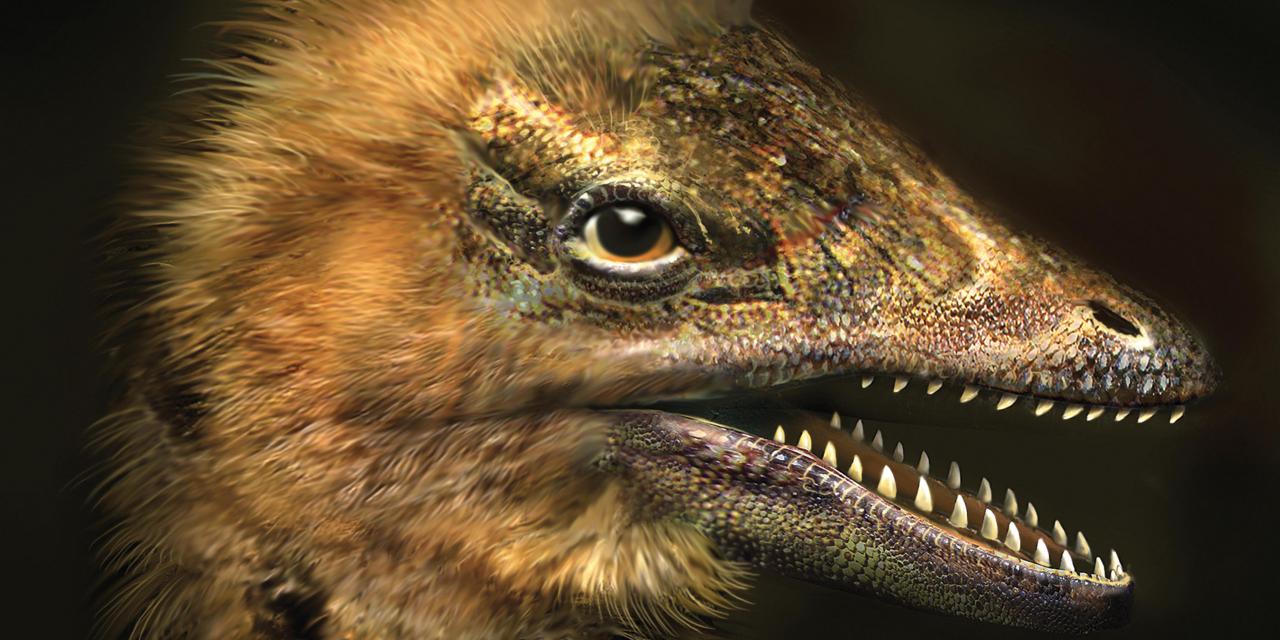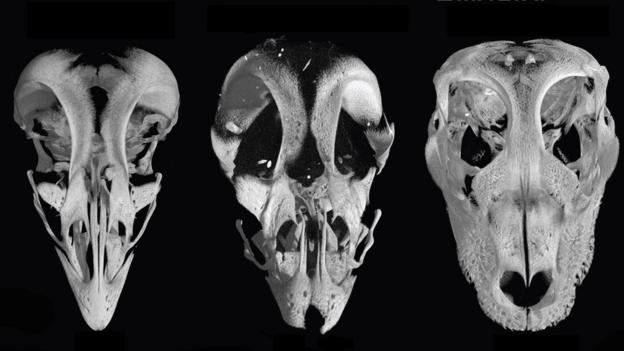I don't see there being a huge ethical issue. They wouldn't have any worse quality of life than <insert fast food chain here>'s farmed chickens. I would think as long as you take reasonable precautions against escape you'd be good to go.The BBC wrote:
A chicken embryo with a dinosaur-like snout instead of a beak has been developed by scientists
Presented by
Melissa Hogenboom
Sixty-five million years ago, an asteroid is believed to have crashed into Earth. The impact wiped out huge numbers of species, including almost all of the dinosaurs.
One group of dinosaurs managed to survive the disaster. Today, we know them as birds.
The idea that birds evolved from dinosaurs has been around since the 19th century, when scientists discovered the fossil of an early bird called Archaeopteryx. It had wings and feathers, but it also looked a lot like a dinosaur. More recent fossils look similar.
But these early birds didn't look the same as modern ones. In particular, they didn't have beaks: they had snouts, like those of their dinosaur ancestors.
To understand how one changed into another, a team has been tampering with the molecular processes that make up a beak in chickens.
By doing so, they have managed to create a chicken embryo with a dinosaur-like snout and palate, similar to that of small feathered dinosaurs like Velociraptor. The results are published in the journal Evolution.
The team's aim was to understand how the bird beak evolved, because the beak is such a vital part of bird anatomy. It has been crucial for their success. The 10,000 or more bird species occupy a wide range of habitats, and many have specialised beaks to help them survive.
But they did not set out to create a "dino-chicken", say lead authors Bhart-Anjan Bhullar of Yale University in New Haven and Arhat Abzhanov of Harvard University in Cambridge.
"Whenever you examine an important evolutionary transformation, you want to learn the underlying mechanism," says Bhullar.
The beak is also the part of the avian skeleton that has "diversified most extensively and most radically", says Bhullar.
Despite this diversity – ranging from flamingos to pelicans - very little work has been done to figure out "what the heck a beak actually is", he adds.
"I wanted to know what the beak was skeletally, functionally and when this major transformation occurred from a normal vertebrate snout to the very unique structures used in birds."
To begin to understand this, the team trawled though changes in the ways genes are expressed in the embryos of chickens and several other animals. They looked at the embryos of mice, emus, alligators, lizards and turtles, representing many of the major animal groups.
They found that birds have a unique cluster of genes related to facial development, which the non-beaked creatures lacked.
When they silenced these genes, the beak structure reverted back to its ancestral state. So too did the palatal bone in the roof of the mouth.
Control chicken embryo, altered chicken embryo and alligator embryo
To make this genetic tweak, Bhullar and his colleagues isolated the proteins that would have gone on to develop beaks. Then they suppressed them using tiny beads coated with an inhibiting substance.
When their skeletons started to develop inside the eggs, these animals had short, rounded bones instead of elongated, fused beaks that bird skeletons have.
"By affecting this early protein you are actually altering gene expression," added Bhullar.
The work highlights that beaks develop very differently from snouts, using a different set of genes, says Michael Benton of Bristol University in the UK. "That's what proves the beak is a real adaptation or 'thing', not just a slightly different nose shape."
The shift from snouts to beaks happened well into the evolution of birds, 40-50 million years after Archaeopteryx, says Benton.
For now Bhullar has no plans, or ethical approval, to hatch the snouted chickens. But he believes they would have been able to survive "just fine".
"These weren't drastic modifications," says Bhullar. "They are far less weird than many breeds of chicken developed by chicken hobbyists and breeders."
"The rest of the animal looked OK, but one needs to think about this carefully from an ethical point of view."
Devolving chickens back to dinosaurs
Moderator: Alyrium Denryle
Devolving chickens back to dinosaurs
I've often wondered if this was doable. It seems I'm not the only one:
Children of the Ancients
I'm sorry, but the number you have dialed is imaginary. Please rotate the phone by 90 degrees and try again.
I'm sorry, but the number you have dialed is imaginary. Please rotate the phone by 90 degrees and try again.
- Broomstick
- Emperor's Hand
- Posts: 28846
- Joined: 2004-01-02 07:04pm
- Location: Industrial armpit of the US Midwest
Re: Devolving chickens back to dinosaurs
Since this is NOT a genetic change but an artificially induced modification of development even if they did escape it's not like they could give rise to a mutant dino-chicken species. They aren't dino-chickens or "devolved", they're deformed chickens.
A life is like a garden. Perfect moments can be had, but not preserved, except in memory. Leonard Nimoy.
Now I did a job. I got nothing but trouble since I did it, not to mention more than a few unkind words as regard to my character so let me make this abundantly clear. I do the job. And then I get paid.- Malcolm Reynolds, Captain of Serenity, which sums up my feelings regarding the lawsuit discussed here.
If a free society cannot help the many who are poor, it cannot save the few who are rich. - John F. Kennedy
Sam Vimes Theory of Economic Injustice
Now I did a job. I got nothing but trouble since I did it, not to mention more than a few unkind words as regard to my character so let me make this abundantly clear. I do the job. And then I get paid.- Malcolm Reynolds, Captain of Serenity, which sums up my feelings regarding the lawsuit discussed here.
If a free society cannot help the many who are poor, it cannot save the few who are rich. - John F. Kennedy
Sam Vimes Theory of Economic Injustice
- Elheru Aran
- Emperor's Hand
- Posts: 13073
- Joined: 2004-03-04 01:15am
- Location: Georgia
Re: Devolving chickens back to dinosaurs
Yeah, this is basically inducing a birth defect by messing with a couple of genes to regress them somewhat down the tree. There would have to be a LOT more work done before they could make it a permanent genetic change that can be transmitted via ordinary reproduction.
It's a strange world. Let's keep it that way.
Re: Devolving chickens back to dinosaurs
Am I correct in my understanding that the picture shown at the top is *not* the actual end result, but more an an "artist's interpretation"?
- Starglider
- Miles Dyson
- Posts: 8709
- Joined: 2007-04-05 09:44pm
- Location: Isle of Dogs
- Contact:
Re: Devolving chickens back to dinosaurs
Yes.biostem wrote:Am I correct in my understanding that the picture shown at the top is *not* the actual end result, but more an an "artist's interpretation"?
This is an example of how evolution works by hacking and tweaking old structures into new more adaptive ones; if it can be done as a (genetically) simple tweak to the expression mechanism for existing genes it (probably) will be. However genes that aren't in use (coding or part of an expression mechanism) will degrade under mutation pressure, so it's not as if there's a complete dinosaur genome hidden in there that we could unlock. It's more that if you were setting out to genetically engineer a neo-dinosaur creature from scratch, a sampling of bird genomes would give you most (but by no means all) of the necessary building blocks.
- Ziggy Stardust
- Sith Devotee
- Posts: 3114
- Joined: 2006-09-10 10:16pm
- Location: Research Triangle, NC
Re: Devolving chickens back to dinosaurs
I'm curious if they examined any potential impacts on this gene silencing on other traits, rather than just beak size. The point of the experiment was obviously just to see if they could isolate genes responsible for beak development, but I would be curious to know just how specific the effect is. I would imagine that the same proteins that are important in beak development would also have other roles in other parts of the body. How does this effect bone density in other parts of the skull? Or other parts of the body? What about on a cellular/molecular level? Being able to modify a gene and achieve a specific effect on the beak is neat and all, but similar techniques have been widely used in other animal vectors in genetic research for years. What would be more interesting is the ability to demonstrate a highly specified response in an organism as complex as a chicken.

